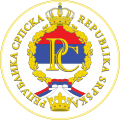 |
|---|
A referendum on remaining in Yugoslavia was held in the parts of Bosnia and Herzegovina with a significant Serb population on 10 November 1991. [1] The referendum was organised by the Bosnian Serb Assembly and asked two questions; to Serbs it asked:
Contents
Do you agree with the decision of Assembly of the Serbian people in Bosnia and Herzegovina of October 24, 1991, that the Serbian people should remain in a common Yugoslav state with Serbia, Montenegro, the SAO Krajina, SAO Slavonija, Baranja and Western Srem, and with others who have come out for remaining? [2]
Non-Serbs were asked:
Are you agreed that Bosnia and Herzegovina, as an equal republic, should remain in a common state of Yugoslavia with all others who take this position? [2]
It was approved by 98% of voters, and Republika Srpska was subsequently established on 9 January 1992. [1]